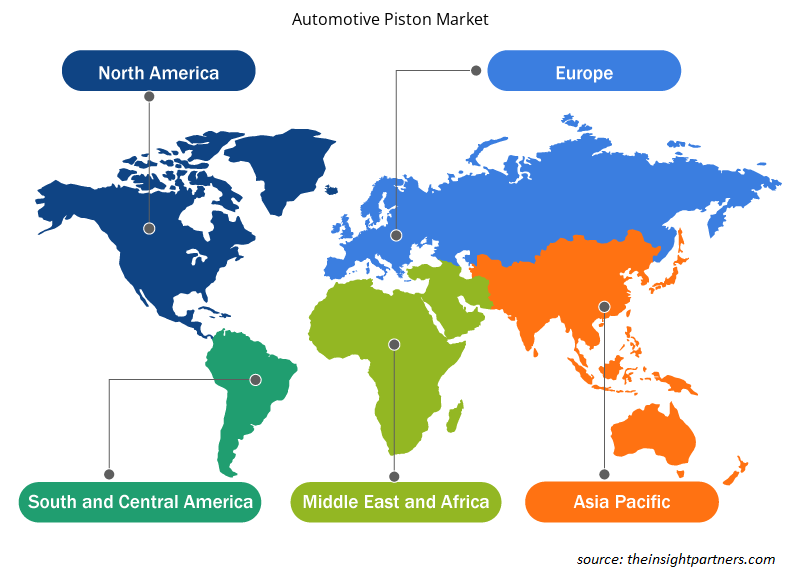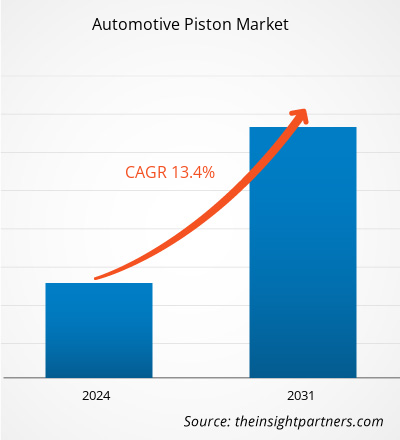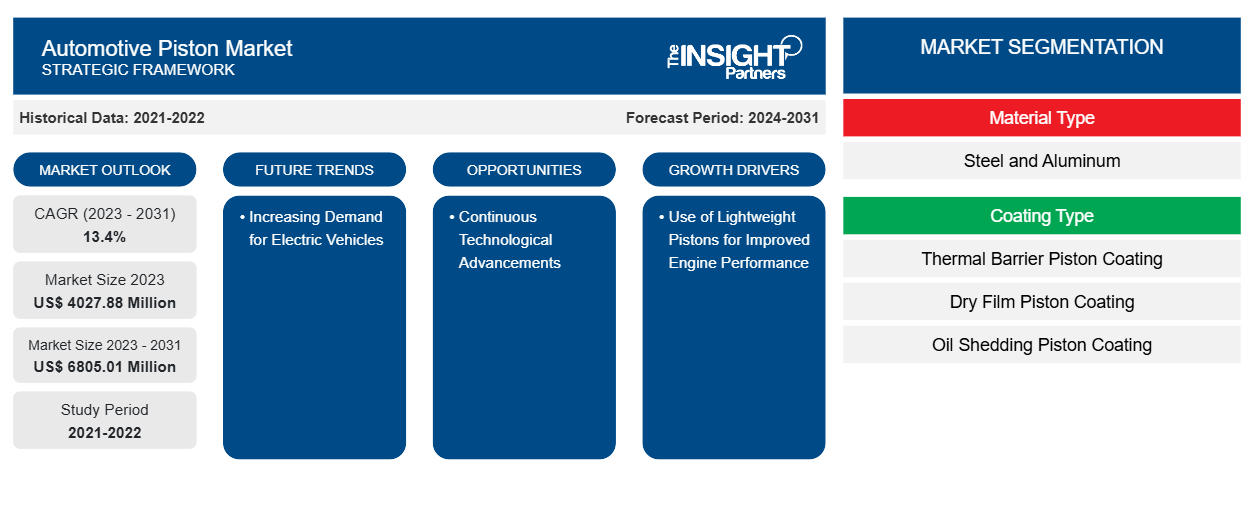Der Markt für Automobilkolben soll von 4027,88 Millionen US-Dollar im Jahr 2023 auf 6805,01 Millionen US-Dollar im Jahr 2031 anwachsen. Der Markt wird zwischen 2023 und 2031 voraussichtlich eine durchschnittliche jährliche Wachstumsrate (CAGR) von 13,4 % verzeichnen. Die steigende Nachfrage nach Elektrofahrzeugen dürfte ein wichtiger Trend auf dem Markt bleiben.
Automobil-Kolben-Marktanalyse
Das Ökosystem des Automobilkolbenmarktes ist vielfältig und entwickelt sich weiter. Es umfasst die folgenden Interessengruppen: Rohstofflieferanten, Automobilkolbenhersteller, OEMs und Endverbraucher. Wichtige Akteure besetzen die verschiedenen Knotenpunkte des Automobilkolbenmarkt-Ökosystems. Die Rohstofflieferanten liefern das Material zum Bau des Automobilkolbens, beispielsweise Stahl, Aluminium und Silizium. Die Automobilkolbenkomponenten bestehen aus Kolbenbolzenbohrung, Kolbenbolzen, Kolbenhemd, Ringnuten und Kolbenringen. Die OEMs auf dem globalen Automobilkolbenmarkt führen verschiedene Prozesse durch, beispielsweise Design, Montage und Produktion, um Rohmaterial in fertige Produkte umzuwandeln.
Zu den Top-5-Playern auf dem Automobilkolbenmarkt gehören Mahle GmbH, Tenneco Inc., Rheinmetall AG, ART Metal MFG Co. Ltd. und TPR Co. Ltd. Diese Unternehmen beteiligen sich aktiv an der Entwicklung robuster Kolben für verschiedene Automobiltypen. Darüber hinaus investieren diese Akteure erhebliches Kapital in entsprechende F&E-Teams, um Kolben zu entwerfen und zu entwickeln, die den Anforderungen der Automobilhersteller entsprechen. Das enorme Volumen der ICE-Automobilproduktion ermöglicht es den Unternehmen, sich kontinuierlich mit der Produktion verschiedener Kolbentypen zu befassen und Umsätze zu erzielen.
Marktübersicht für Automobilkolben
MAHLE GmbH, Tenneco Inc., Rheinmetall AG, ART Metal MFG Co., Ltd und TPR Co. Ltd. sind unter anderem führende Hersteller von Automobilkolben. Die Unternehmen bieten eine breite Palette an Kolben für Großmotoren sowie Kolben für Nutzfahrzeuge , Traktoren und stationäre Motoren an. Diese Kolben werden unter anderem von OEMs wie Volkswagen, Toyota, Volvo, Daimler und Ford Motor Company beschafft. Die Endverbraucher haben eine große Anzahl von Kunden, von Käufern privater Fahrzeuge bis hin zu Flottenbetreibern. Der wachsende Trend zum Downsizing von Motoren, die steigende Fahrzeugproduktion und die hohe Nachfrage nach leichten Kolben dürften Unternehmen, die in diesen Markt einsteigen möchten, erhebliche Chancen bieten.
Passen Sie diesen Bericht Ihren Anforderungen an
Sie erhalten kostenlose Anpassungen an jedem Bericht, einschließlich Teilen dieses Berichts oder einer Analyse auf Länderebene, eines Excel-Datenpakets sowie tolle Angebote und Rabatte für Start-ups und Universitäten.
-
Holen Sie sich die wichtigsten Markttrends aus diesem Bericht.Dieses KOSTENLOSE Beispiel umfasst eine Datenanalyse von Markttrends bis hin zu Schätzungen und Prognosen.
Treiber und Chancen auf dem Automobilkolbenmarkt
Verbesserte Motorleistung durch Einsatz leichter Kolben
Die Erfindung und Verwendung von Kohlenstoff-Kohlenstoff-Verbundwerkstoffen bei der Kolbenherstellung hat zu einer Reduzierung des Kolbengewichts von Motorkomponenten geführt, wodurch der Kolben bei höheren Geschwindigkeiten laufen kann. Dies hat Hersteller auf dem Automobilkolbenmarkt dazu ermutigt, Kohlenstoff-Kohlenstoff-Verbundwerkstoffe anstelle von herkömmlichen Materialien wie Aluminium zu verwenden, um eine verbesserte Motorleistung zu erzielen. Auch Siliziumverbundwerkstoffe und Magnesium werden in den letzten Jahren voraussichtlich verschiedene Möglichkeiten für neue Produkte eröffnen. Die Verwendung von Leichtkolben führt zu einer Reduzierung des Motorgewichts. Dies kommt Fahrzeugen mit Verbrennungsmotor zugute, da es den Kraftstoffverbrauch senkt und die Umweltverschmutzung verringert.
Kontinuierliche technologische Weiterentwicklung
Der hohe Verschleiß von Motorkomponenten aufgrund der steigenden Gesamtlebensdauer von Fahrzeugen fördert den Verkauf von Automobilkolben. Technologische Fortschritte und Automatisierung ermöglichen es produzierenden Unternehmen, ihre Produktivität und Rentabilität zu steigern. MAHLE GmbH, Tenneco Inc., Aisin Seiki Co., Ltd., Hitachi Automotive Systems, Ltd. und Rheinmetall AG gehören zu den wichtigsten Unternehmen auf dem Automobilkolbenmarkt.
Segmentierungsanalyse des Automobilkolbenmarktberichts
Wichtige Segmente, die zur Ableitung der Marktanalyse für Automobilkolben beigetragen haben, sind Materialtyp, Beschichtungstyp und Kolbentyp.
- Basierend auf dem Materialtyp ist der Automobilkolbenmarkt in Stahl und Aluminium segmentiert. Das Aluminiumsegment hatte im Jahr 2023 den größten Marktanteil.
- Basierend auf der Beschichtungsart wurde der Automobilkolbenmarkt in Wärmebarriere-Kolbenbeschichtung, Trockenfilm-Kolbenbeschichtung und Ölabscheide-Kolbenbeschichtung segmentiert. Das Segment der Wärmebarriere-Kolbenbeschichtung hatte im Jahr 2023 einen größeren Marktanteil.
- In Bezug auf den Kolbentyp ist der Automobilkolbenmarkt in Flachkolben, Tellerkolben und Kuppelkolben unterteilt. Das Flachkolbensegment hatte im Jahr 2023 einen größeren Marktanteil.
Marktanteilsanalyse für Automobilkolben nach Geografie
Der geografische Umfang des Marktberichts für Automobilkolben ist hauptsächlich in fünf Regionen unterteilt: Nordamerika, Asien-Pazifik, Europa, Naher Osten und Afrika sowie Süd- und Mittelamerika.
Der Umfang des Berichts zum Automobilkolbenmarkt umfasst Nordamerika (USA, Kanada und Mexiko), Europa (Russland, Großbritannien, Frankreich, Deutschland, Italien und den Rest Europas), den asiatisch-pazifischen Raum (Südkorea, Indien, Australien, Japan, China und den Rest des asiatisch-pazifischen Raums), den Nahen Osten und Afrika (Saudi-Arabien, Südafrika, die Vereinigten Arabischen Emirate und den Rest des Nahen Ostens und Afrikas) sowie Süd- und Mittelamerika (Argentinien, Brasilien und den Rest Süd- und Mittelamerikas). In Bezug auf den Umsatz dominierte der asiatisch-pazifische Raum im Jahr 2023 den Marktanteil von Automobilkolben. Europa ist der zweitgrößte Beitragszahler zum globalen Automobilkolbenmarkt, gefolgt von Nordamerika.
Regionale Einblicke in den Automobilkolbenmarkt
Die regionalen Trends und Faktoren, die den Automobilkolbenmarkt während des Prognosezeitraums beeinflussen, wurden von den Analysten von Insight Partners ausführlich erläutert. In diesem Abschnitt werden auch die Marktsegmente und die Geografie des Automobilkolbenmarkts in Nordamerika, Europa, im asiatisch-pazifischen Raum, im Nahen Osten und Afrika sowie in Süd- und Mittelamerika erörtert.

- Erhalten Sie regionale Daten zum Automobilkolbenmarkt
Umfang des Marktberichts für Automobilkolben
| Berichtsattribut | Details |
|---|---|
| Marktgröße im Jahr 2023 | 4027,88 Millionen US-Dollar |
| Marktgröße bis 2031 | 6805,01 Millionen US-Dollar |
| Globale CAGR (2023 - 2031) | 13,4 % |
| Historische Daten | 2021-2022 |
| Prognosezeitraum | 2024–2031 |
| Abgedeckte Segmente |
Nach Materialtyp
|
| Abgedeckte Regionen und Länder |
Nordamerika
|
| Marktführer und wichtige Unternehmensprofile |
|
Dichte der Marktteilnehmer für Automobilkolben: Auswirkungen auf die Geschäftsdynamik verstehen
Der Markt für Automobilkolben wächst rasant, angetrieben durch die steigende Nachfrage der Endverbraucher aufgrund von Faktoren wie sich entwickelnden Verbraucherpräferenzen, technologischen Fortschritten und einem größeren Bewusstsein für die Vorteile des Produkts. Mit steigender Nachfrage erweitern Unternehmen ihr Angebot, entwickeln Innovationen, um die Bedürfnisse der Verbraucher zu erfüllen, und nutzen neue Trends, was das Marktwachstum weiter ankurbelt.
Die Marktteilnehmerdichte bezieht sich auf die Verteilung der Firmen oder Unternehmen, die in einem bestimmten Markt oder einer bestimmten Branche tätig sind. Sie gibt an, wie viele Wettbewerber (Marktteilnehmer) in einem bestimmten Marktraum im Verhältnis zu seiner Größe oder seinem gesamten Marktwert präsent sind.
Die wichtigsten auf dem Automobilkolbenmarkt tätigen Unternehmen sind:
- Arias Pistons
- Art Metal Mfg., Ltd
- Steinbock Automobile
- QUFU JINHUANG KOLBEN CO., LTD
- Hitachi Astemo Americas, Inc
- RIKEN Corporation
Haftungsausschluss : Die oben aufgeführten Unternehmen sind nicht in einer bestimmten Reihenfolge aufgeführt.

- Überblick über die wichtigsten Akteure auf dem Automobilkolbenmarkt
Neuigkeiten und aktuelle Entwicklungen zum Automobilkolbenmarkt
Der Automobilkolbenmarkt wird durch die Erfassung qualitativer und quantitativer Daten nach Primär- und Sekundärforschung bewertet, die wichtige Unternehmensveröffentlichungen, Verbandsdaten und Datenbanken umfasst. Nachfolgend sind einige der Entwicklungen auf dem Automobilkolbenmarkt aufgeführt:
- Aquarius Engines aus Israel hat eine wasserstoffbetriebene Version seines leichten Einkolben-Linearmotors entwickelt, der mit seiner einzigartigen Fähigkeit zum internen Gasaustausch zur Reduzierung der Emissionen einzigartig gestaltet ist. (Quelle: Aquarius Engines, Pressemitteilung, Mai 2021)
Bericht zum Markt für Automobilkolben – Umfang und Ergebnisse
Der Bericht „Marktgröße und Prognose für Automobilkolben (2021–2031)“ bietet eine detaillierte Analyse des Marktes, die die folgenden Bereiche abdeckt:
- Automobilkolbenmarktgröße und -prognose auf globaler, regionaler und Länderebene für alle wichtigen Marktsegmente, die im Rahmen des Berichts abgedeckt sind
- Trends auf dem Automobilkolbenmarkt sowie Marktdynamik wie Treiber, Einschränkungen und wichtige Chancen
- Detaillierte PEST- und SWOT-Analyse
- Analyse des Automobilkolbenmarkts mit Blick auf wichtige Markttrends, globale und regionale Rahmenbedingungen, wichtige Akteure, Vorschriften und aktuelle Marktentwicklungen
- Branchenlandschaft und Wettbewerbsanalyse, einschließlich Marktkonzentration, Heatmap-Analyse, prominenten Akteuren und aktuellen Entwicklungen auf dem Automobilkolbenmarkt
- Detaillierte Firmenprofile
- Historische Analyse (2 Jahre), Basisjahr, Prognose (7 Jahre) mit CAGR
- PEST- und SWOT-Analyse
- Marktgröße Wert/Volumen – Global, Regional, Land
- Branchen- und Wettbewerbslandschaft
- Excel-Datensatz
Aktuelle Berichte
Erfahrungsberichte
Grund zum Kauf
- Fundierte Entscheidungsfindung
- Marktdynamik verstehen
- Wettbewerbsanalyse
- Kundeneinblicke
- Marktprognosen
- Risikominimierung
- Strategische Planung
- Investitionsbegründung
- Identifizierung neuer Märkte
- Verbesserung von Marketingstrategien
- Steigerung der Betriebseffizienz
- Anpassung an regulatorische Trends























 Kostenlose Probe anfordern für - Automobilkolbenmarkt
Kostenlose Probe anfordern für - Automobilkolbenmarkt